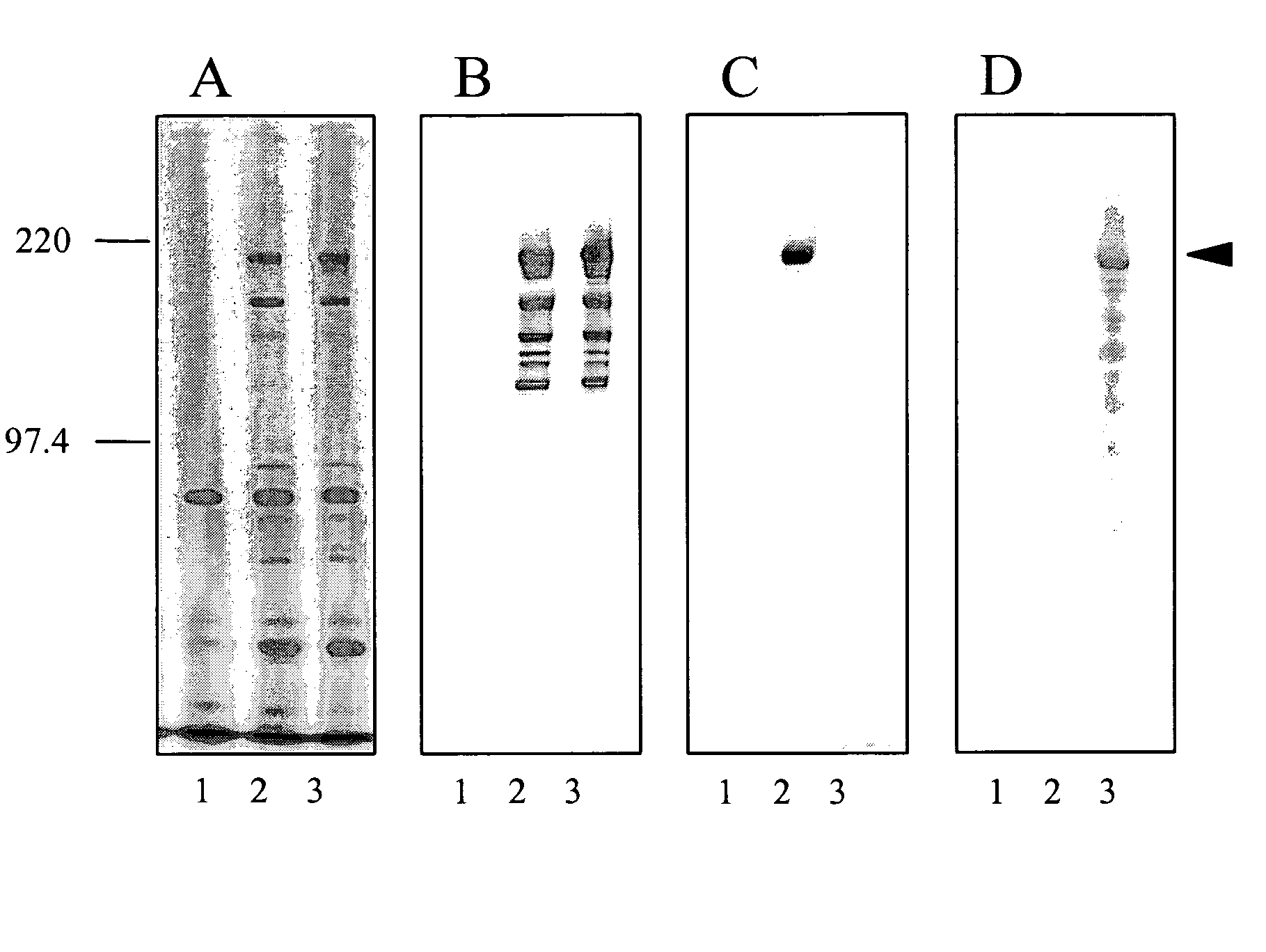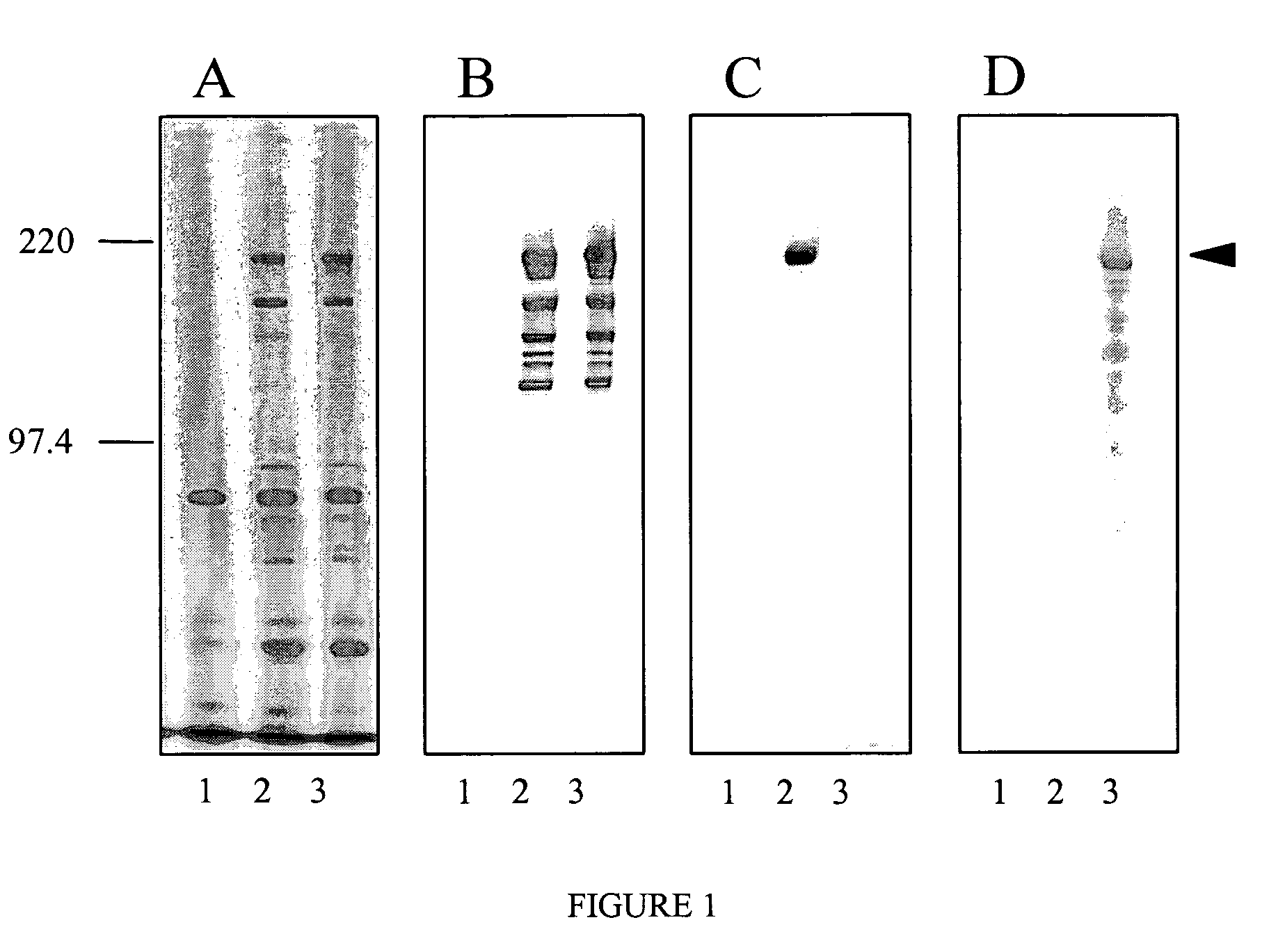Lactic acid bacteria as agents for treating and preventing allergy
a technology allergy treatment, applied in the field of new strains of lactic acid bacteria, can solve the problems of increasing the number of individuals suffering from allergies, time-consuming, and proceeding accordingly
- Summary
- Abstract
- Description
- Claims
- Application Information
AI Technical Summary
Benefits of technology
Problems solved by technology
Method used
Image
Examples
example 1
Construction of Recombinant Polypeptide
[0034]Two peptides were fused with the cell surface anchored protease of L. bulgaricus to be displayed on the surface of the bacterium La1, i.e. the peptide ε4 and another peptide (used as a control) derived from Tetanus Toxin (termed TT in the following sequence, see below).
[0035]The mimotope (ε4) was fused in frame to the cell surface proteinase (PrtB) from Lactobacillus bulgaricus (Gilbert et al., (1996) J. Bacteriol, 178, 3059-3065).
[0036]The protease gene was first amplified with its promoter by using the following two primers:
[0037]
5′-TTTTGTGGATCCTTAACTTCATAGCACG-3′(SEQ ID NO:20)(upstream the promoter of the gene,carrying a BamHI site)5′-ATATTATCTAGAATTGAATAGATTGCC-3′(SEQ ID NO:21)(downstream the rho-independentterminator of the gene, carrying aXbaI site)
[0038]The amplification product was cleaved with BamHI and XbaI and cloned in the lactic acid bacteria vector pNZ124, that had been digested with the same restriction enzymes, and eventua...
example 2
Transformation of Lactobacillus johnsonii
[0043]For transformation purposes Lactobacillus johnsonii strain La1 (available from the Institute Pasteur under the accession no. CNCM I-1225) was grown overnight in MRS broth at 37° C. in anaerobic conditions. An aliquot of this culture was used to inoculate (1:10) another culture broth (MRS) containing 0.5 M sucrose. After an additional re-inoculation at 2% into 200 ml MRS+0.5 M sucrose the culture was grown to an OD595 of 0.6. The cells were collected by centrifuging at 5000 rpm at 4° C. for 10 minutes, the pellet was washed twice with ½ volume of a solution containing 1M sucrose and 2.5 mM CaCl2, once with ¼ volume of a solution containing 1 M sucrose, 2.5 mM CaCl2) and the pellet obtained after centrifugation was resuspended in 3.5 ml of a solution of 1 M sucrose, 2.5 mM CaCl2+0.459 ml 87% glycerol (10% final concentration). The cells were either directly used for transformation or frozen at −80° C.
[0044]For the electroporation 40 εμl ...
example 3
Generation of Antisera Against the Proteinase PrtB
[0045]To generate antisera against the PrtB rabbits were immunized subcutaneously with Lactobacillus delbrueckii subsp. bulgaricus strain ATCC11842 expressing proteinase B (PrtB). Bacteria were grown overnight in MRS broth at 42° C. in a GasPak anaerobic system. An aliquot of this culture was used to inoculate another culture broth (MRS) containing 0.5 M sucrose and the culture was grown for 5 hours at 42° C. until an OD595 of 0.6. The cells were collected by centrifuging at 5000 rpm at 4° C. for 10 minutes, the pellet was washed twice with 10 ml PBS and then resuspended in 2 ml PBS. Rabbits were immunized three times at two weeks intervals with 1.5 ml PBS resuspended cells and seven days after the last feeding rabbits were bled. Serum was purified six times on 2×109 Lactobacillus johnsonii (La1).
PUM
| Property | Measurement | Unit |
|---|---|---|
| Strain point | aaaaa | aaaaa |
Abstract
Description
Claims
Application Information
 Login to View More
Login to View More - R&D
- Intellectual Property
- Life Sciences
- Materials
- Tech Scout
- Unparalleled Data Quality
- Higher Quality Content
- 60% Fewer Hallucinations
Browse by: Latest US Patents, China's latest patents, Technical Efficacy Thesaurus, Application Domain, Technology Topic, Popular Technical Reports.
© 2025 PatSnap. All rights reserved.Legal|Privacy policy|Modern Slavery Act Transparency Statement|Sitemap|About US| Contact US: help@patsnap.com



